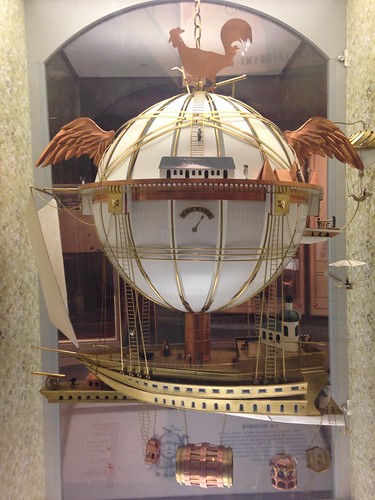
Volume XIII, Issue IV
Around the World in 80 Days
By Jules Verne, Chapter II
In which Passepartout is Convinced that he has at Last Found His Ideal
Faith,” muttered Passepartout, somewhat flurried, “I’ve seen people at Madame Tussaud’s as lively as my new master!”
Madame Tussaud’s “people,” let it be said, are of wax, and are much visited in London; speech is all that is wanting to make them human.
During his brief interview with Mr. Fogg, Passepartout had been carefully observing him. He appeared to be a man about forty years of age, with fine, handsome features, and a tall, well-shaped figure; his hair and whiskers were light, his forehead compact and unwrinkled, his face rather pale, his teeth magnificent. His countenance possessed in the highest degree what physiognomists call “repose in action,” a quality of those who act rather than talk. Calm and phlegmatic, with a clear eye, Mr. Fogg seemed a perfect type of that English composure which Angelica Kauffmann has so skilfully represented on canvas. Seen in the various phases of his daily life, he gave the idea of being perfectly well-balanced, as exactly regulated as a Leroy chronometer. Phileas Fogg was, indeed, exactitude personified, and this was betrayed even in the expression of his very hands and feet; for in men, as well as in animals, the limbs themselves are expressive of the passions.
He was so exact that he was never in a hurry, was always ready, and was economical alike of his steps and his motions. He never took one step too many, and always went to his destination by the shortest cut; he made no superfluous gestures, and was never seen to be moved or agitated. He was the most deliberate person in the world, yet always reached his destination at the exact moment.
He lived alone, and, so to speak, outside of every social relation; and as he knew that in this world account must be taken of friction, and that friction retards, he never rubbed against anybody.
As for Passepartout, he was a true Parisian of Paris. Since he had abandoned his own country for England, taking service as a valet, he had in vain searched for a master after his own heart. Passepartout was by no means one of those pert dunces depicted by Moliere with a bold gaze and a nose held high in the air; he was an honest fellow, with a pleasant face, lips a trifle protruding, soft-mannered and serviceable, with a good round head, such as one likes to see on the shoulders of a friend. His eyes were blue, his complexion rubicund, his figure almost portly and well-built, his body muscular, and his physical powers fully developed by the exercises of his younger days. His brown hair was somewhat tumbled; for, while the ancient sculptors are said to have known eighteen methods of arranging Minerva’s tresses, Passepartout was familiar with but one of dressing his own: three strokes of a large-tooth comb completed his toilet.
It would be rash to predict how Passepartout’s lively nature would agree with Mr. Fogg. It was impossible to tell whether the new servant would turn out as absolutely methodical as his master required; experience alone could solve the question. Passepartout had been a sort of vagrant in his early years, and now yearned for repose; but so far he had failed to find it, though he had already served in ten English houses. But he could not take root in any of these; with chagrin, he found his masters invariably whimsical and irregular, constantly running about the country, or on the look-out for adventure. His last master, young Lord Longferry, Member of Parliament, after passing his nights in the Haymarket taverns, was too often brought home in the morning on policemen’s shoulders. Passepartout, desirous of respecting the gentleman whom he served, ventured a mild remonstrance on such conduct; which, being ill-received, he took his leave. Hearing that Mr. Phileas Fogg was looking for a servant, and that his life was one of unbroken regularity, that he neither travelled nor stayed from home overnight, he felt sure that this would be the place he was after. He presented himself, and was accepted, as has been seen.
At half-past eleven, then, Passepartout found himself alone in the house in Saville Row. He begun its inspection without delay, scouring it from cellar to garret. So clean, well-arranged, solemn a mansion pleased him; it seemed to him like a snail’s shell, lighted and warmed by gas, which sufficed for both these purposes. When Passepartout reached the second story he recognised at once the room which he was to inhabit, and he was well satisfied with it. Electric bells and speaking-tubes afforded communication with the lower stories; while on the mantel stood an electric clock, precisely like that in Mr. Fogg’s bedchamber, both beating the same second at the same instant. “That’s good, that’ll do,” said Passepartout to himself.
He suddenly observed, hung over the clock, a card which, upon inspection, proved to be a programme of the daily routine of the house. It comprised all that was required of the servant, from eight in the morning, exactly at which hour Phileas Fogg rose, till half-past eleven, when he left the house for the Reform Club — all the details of service, the tea and toast at twenty-three minutes past eight, the shaving-water at thirty-seven minutes past nine, and the toilet at twenty minutes before ten. Everything was regulated and foreseen that was to be done from half-past eleven a.m. till midnight, the hour at which the methodical gentleman retired.
Mr. Fogg’s wardrobe was amply supplied and in the best taste. Each pair of trousers, coat, and vest bore a number, indicating the time of year and season at which they were in turn to be laid out for wearing; and the same system was applied to the master’s shoes. In short, the house in Saville Row, which must have been a very temple of disorder and unrest under the illustrious but dissipated Sheridan, was cosiness, comfort, and method idealised. There was no study, nor were there books, which would have been quite useless to Mr. Fogg; for at the Reform two libraries, one of general literature and the other of law and politics, were at his service. A moderate-sized safe stood in his bedroom, constructed so as to defy fire as well as burglars; but Passepartout found neither arms nor hunting weapons anywhere; everything betrayed the most tranquil and peaceable habits.
Having scrutinised the house from top to bottom, he rubbed his hands, a broad smile overspread his features, and he said joyfully, “This is just what I wanted! Ah, we shall get on together, Mr. Fogg and I! What a domestic and regular gentleman! A real machine; well, I don’t mind serving a machine.”
(to be continued)
Elysian Lilies
Photos by Bob Kirchman




Building a Better World
By Bob Kirchman
The Summer Reading Program at the Augusta County Library caught my attention. The theme was 'Building a Better World.' I eagerly went to their web page in the hopes of finding some of the excitement that had propelled me towards literature as a young person. I was a bit disappointed that the program description on the website merely told the young people that if they kept a log of their reading hours that they would be in the running for prizes to be announced at the end of the Summer.
Now there is nothing wrong with logging one's reading hours in itself, if one so desires. And there is nothing wrong with giving out incentives, but as one who avoided such programs like the plague myself, I'd like to open this up for discussion.
When I was a young fourth grader, a kindly librarian opened up new worlds for me by freeing me from the restrictions of 'age appropriate' literature. She led me to a section for older readers and helped me pick out a book about people exploring Mars. She freed me from the twattle that was bogging down so many of my peers. At home, my Dad would read to me from a big volume of King Arthur. I am happy to see my son-in-law reading the same to my granddaughter. There was an exciting world to explore that not everyone wanted me to have access to. I was shown a path and it led to adventure.
I discovered Gulliver's Travels and wondered at imagining myself a friendly giant to a similar people. I discovered Tom Swift and his endless parade of outlandish inventions. I discovered Jules Verne and his Voyages Exraordinaires! It would be years before I grasped that Gulliver's Travels was a political satire and other fine points, but the seed had been planted. My enthusiasm, though dulled by the school system's required reading program for classes, was rekindled when I discovered C. S. Lewis and Tolkien!
The Voyages extraordinaires (literally Extraordinary Voyages or Extraordinary Journeys) is a sequence of fifty-four novels by the French writer Jules Verne, originally published between 1863 and 1905.
According to Verne's editor Pierre-Jules Hetzel, the goal of the Voyages was "to outline all the geographical, geological, physical, and astronomical knowledge amassed by modern science and to recount, in an entertaining and picturesque format ... the history of the universe."
Verne's meticulous attention to detail and scientific trivia, coupled with his sense of wonder and exploration, form the backbone of the Voyages. Part of the reason for the broad appeal of his work was the sense that the reader could really learn knowledge of geology, biology, astronomy, paleontology, oceanography and the exotic locations and cultures of world through the adventures of Verne's protagonists. This great wealth of information distinguished his works as "encyclopedic novels".Wikipedia
The stories of Les Voyages Extraordinaires were originally published as serials in magazines. Later they would find their place as lavishly illustrated special editions but the point is that they had a more organic beginning than much of today's literature. They are fascinating because they are predictive of a fair amount of modern invention and technology. No doubt, if I were in charge of the library program, I would be engaging the services of local radio voice John Ihrig to read passages from Jules Verne. There would be a Fantastic Flying Machine contest and other events to inspire.

La Minerve was designed by the French aeronaut Etienne Robertson in 1803. Robertson's self-contained aerial community represents the hopes which many Europeans had in the bright future of air travel. This modern model of Robertson's design is in the Smithsonian Air and Space Museum.
To be fair, I did not actually follow up with the library. Hopefully their program incorporates such elements but if I were running it, they would be front and center on the website. If I'm a reluctant reader, I'm simply not getting past the hours logging. I work with young people and. they tell me straight-up that nobody reads anymore. Films are their literature. I've challenged a few of them that they can get past this. There are those young people who have actually been in my studio who are avid readers and who can discuss it well.
Then there is PONTIFUS. I was a bit distressed by the over-saturation of the youth offerings with dystopian themes, particularly as I saw that the noble ideals that once propelled our society were being discredited in the academy. A number of people in our church seemed preoccupied with the 'Prepper' movement and as a result were (perhaps unthinkingly) no longer offering hope based in timeless truth to our young people. So PONTIFUS is my feeble attempt to offer the possibility of building a better world. It was quite inspired by Verne's Voyages Extraordinaires, for it is predictive of a new inventiveness leading to a 'New World' in the tundra regions. It incorporates ideas I have found in sources such as City Journal and elsewhere that point to new horizons.
I did not write PONTIFUS to sell books. I do not even know if it is good enough to stand as literature, but like Les Voyages, it is encyclopedic of things I would pass along to young hearts in the world today. It is important to me as a repository for that body of ideas. I realize now that it is something I HAD to write... something burning within me. That is a desire to build for young people a bridge to the Kingdom that for me inspires those lofty aspirations!

Magic Garden Visitor. Photo by Bob Kirchman
J. R. R. Tolkien and C. S. Lewis
Reconciling Reason and Imagination
Two friends, J. R. R. Tolkien and C. S. Lewis had a common love of the great myth. The two observed that for many centuries cultures communicated their greatest truths through myth and legend. They lamented the rational society they lived in’s relegation of these myths to ‘children’s stories,’ as they knew grown men and women… even great warriors relished these tales and the great thoughts they conveyed. These tales connected emotionally with their readers and tellers. These stories contained great insight into life and truth that could be observed as well as providing a glimpse into the world unseen, the spiritual realm.
Before coming to faith in Christ, Lewis lamented to Tolkien that it was a shame that the great myths were not true. Tolkien responded that they indeed contained great truths, and walking on Addison’s Walk on the grounds of Magdalen College, Tolkien helped the struggling Lewis reconcile reason and imagination. “The Gospels had all the qualities of great human storytelling. But they portrayed a true event - God the storyteller entered his own story, in the flesh, and brought a joyous conclusion from a tragic situation. Suddenly Lewis could see that the nourishment he had always received from great myths and fantasy stories was a taste of the greatest, truest story — of the life, death and resurrection of Christ.” —Chris Armstrong writes in Christianity Today. Lewis and Tolkien insisted that reason and imagination must be integrated — in any understanding of truth, the whole person must be satisfied.
In 1936 J. R. R. Tolkien had just written The Hobbit and the two friends began to think of a scheme to reignite myth in modern culture. They decided upon science fiction as a vehicle of ‘modern myth’ and assigned themselves topics that would inspire serious works for modern readers. Lewis would write about ‘Space Travel’ and Tolkien ‘Time Travel.’ Out of the Silent Planet, Perelandra, and That Hideous Strength — the “Space Trilogy” or the “Ransom Trilogy” was Lewis’s offering for ‘Space Travel.’ It fictionalizes a very serious line of thought that he develops in The Abolition of Man, which is really just the publication of a series of lectures he delivered.
Tolkien’s Trilogy became The Lord of the Rings and departed somewhat from the assignment, but it is a great work that has become a classic mythology for modern readers. Tolkien and Lewis sought most of all to bring the type of literature they themselves loved to modern readers. Tolkien himself said to Lewis: “I relish stories that survey the depths of space and time.” I discovered Lewis’s Narnia as a young adult and it brought me to a deeper feeling/understanding of my own faith. My young granddaughter knows these stories as a child and her world is the richer for it. In my youth I had read quite a bit of Jules Verne’s Voyages Extraordinaire and they certainly fueled my imagination. In Around the World in Eighty Days he deals not so much with time travel per se, but the concept of global travel and the ‘lost’ day.

The Inuit live on both sides of the International Date Line. Before travel was restricted by the world's two great superpowers they could literally cross the Bering Strait into another day. Journey to Jesus Mural by Kristina Elaine Greer and Bob Kirchman
Looking at a mural that I was painting with Kristina Elaine Greer of the world’s children ‘around the globe’ that point where you can literally ‘step into tomorrow’ became the inspiration for what I originally intended as a short story — Dinner Stop at the End of the World which originally offered itself as an alternative to some of the dystopian apocalyptic ‘Christian’ literature that was coming out at the time. I was notably concerned that there were people in Bible studies I knew taking all too seriously the work of one author in particular who mixed mysticism with prophecy to create a bit of an alarmist message as his protagonist would continually meet a mysterious ‘prophet’ figure who would give him a new piece of the ‘puzzle’ concerning the judgement of America. It was an intriguing work of fiction — not much on plot, mind you, but it did get you thinking about Biblical prophecy. The problems I had with it were twofold, first of all it created a dark scenario and did not offer much in the way of light or hope. Secondly, it based much of its proclamations not so much on scripture but a form of mysticism that is found in Judaism.
It wasn’t that great a story. Still, the author was appearing on Jim Bakker’s show (yes, he’s still around) and his message was punctuated by advertisements for ‘survival food.’ The publisher produced a companion ‘study guide.’ People were actually directing their lives in response to an interesting work of fiction! What I found tragic was that we were putting aside the inspiration of the younger generation who must have dismissed a lot of this adult behavior as ‘over the top.’ I’m not writing this to dump on someone who’s published a lot of books but rather to say that he did me one great favor — he pushed me to write out of my own imagination and yes a sense of reason that is rooted in the 23rd Psalm which states that “The Lord is my shepherd.” That drove me to do my own study of history. I found that though indeed there were terrible things that sinful man had done, there were the great stories of Redemption as well. Redemption, I would discover, is the ultimate story of time travel for it takes us from death to life — from finite existence to the very doorway to eternity. my own little story grew into PONTIFUS.
APOLLONIUS is my attempt to delve into ’Space Travel.’ As in PONTIFUS, I find myself looking to Lewis a lot… as to Jules Verne who had been my inspiration in youth. I used to draw fanciful flying machines and such. But in all of this, I rather liken to fancy a conversation ongoing at ‘Eagle and Child’ that can inspire us even in our day. Sitting on top of a mountain in Shenandoah Park with my friend Ebenezer Murengezi, we met a hiker. He walked up to the place we were sitting — a gentleman from Alaska, the son of dairy farmers, and he was hiking the entire Appalachian Trail. We were enjoying pleasant conversation when Ebenezer and I remarked at how much nature showed you the wonder of God. “What do you think?” Ebenezer asked the gentleman. “I’m a scientist.” he replied. By that he meant he had no use for our “fables.” He said he had believed as a child but that he was taught “better” by the university he attended. I asked him if he’d ever simply asked God to show Himself to him and he said “I’ve already been there.” I replied “Perhaps God hasn’t finished yet.” At this point the poor gentleman made a hasty exit. I bring this up merely to point out that I DON’T think the issue was resolved for him. In the realm of Reason, God had been discarded. In the realm of Imagination, however, questions had NOT been sufficiently put to rest.
Lewis had his childhood faith put to rest by his mentor William Kirkpatrick, or "The Great Knock," who appears in the Narnia books as Digory Kirk — and far more open to possibilities beyond our world because he’s been there. It was that time of rediscovery with Tolkien that brought C. S. Lewis to great faith. I pray that the gentleman we met on the mountain will find his J. R. R. Tolkien, The resolution of reason and imagination, and most of all FAITH!
Magnolia Blossom
Photos by Bob Kirchman



Day Lily
Photos by Bob Kirchman



